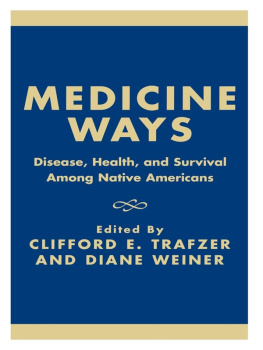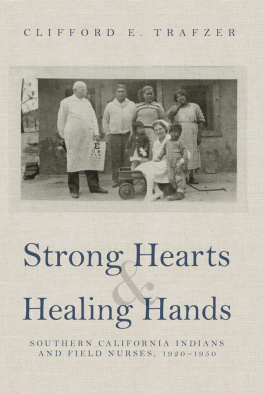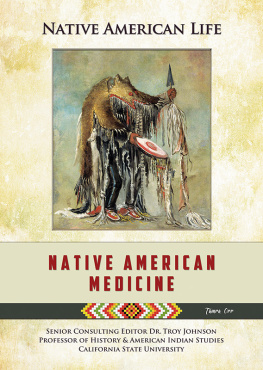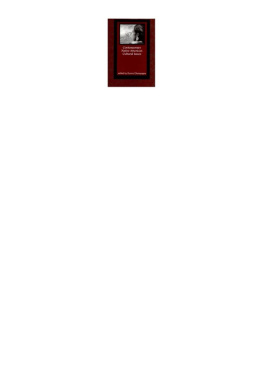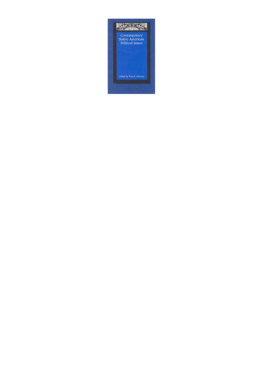ABOUT THE CONTRIBUTORS
DONNA L. AKERS (Choctaw) is an assistant professor of history at Purdue University.
TODD BENSON wrote his Ph.D. on the history of federal Indian health care policy during the first half of the twentieth century. He is currently associate director of advising at the Stanford School of Medicine.
LINDA BURHANSSTIPANOV (Western Cherokee) has been working in Native American Cancer Prevention and Control since the latter part of the 1980s. She is the executive director of Native American Cancer Research, and Indian-owned and operated non-profit corporation.
JOHN CASKEN is an assistant professor, University of Hawaii at Manoa, School of Public Health/School of Medicine. He has had extensive experience in the recruitment of American Indians and Alaska Natives into higher educational institutions, and teaches in the area of indigenous health care.
EDWARD D. Castillo (Cahuilla-Luiseo Mission descendant) is a professor of Native American Studies at Sonoma State University. He is a nationally recognized author and expert on California Indian history.
DOUGLAS FREEMAN, JR. (cover art) is an artist for Gravitywell Productions, a web-based provider of comic books, animated cartoons, and illustrations. He can be reached and his work viewed at < http://wwwgravitywell.com >.
JAMES HAMPTON (Choctaw and Chickasaw) is one of two Native American oncologists in the United States. He has been recognized as a community and professional advocate for Native American cancer-prevention and -control efforts for more than 30 years. He is chair of the National Network of Cancer Control Research among American Indian and Alaska Native Populations.
JEANETTE HASSIN, Ph.D. is a medical anthropologist and consultant to the College of Public Health, the Arizona Cessation Training and Evaluation Unit at the University of Arizona. Her major interests are substance abuse and contemporary American Indian health and community issues.
ERIC HENDERSON is a social anthropologist in the Department of Social Sciences, Great Basin College.
FELICIA SCHANCHE HODGE, Dr. PH., is a Wailaki Indian from Northern California. She is the director of the Center for American Indian Research and Education at the University of California, San Francisco and is professor of nursing at the University of Minnesota. Dr. Hodge has received numerous research grants in areas of cancer prevention and control, smoking cessation, nutrition, diabetes and wellnessall targeting American Indian and Alaska Native populations. She is a member of the University Breast Cancer Research Council, on the board of SACNAS, and a member of the National Cancer Institute Directors Consumer Liaison Group.
TROY JOHNSON is an associate professor of American Indian studies and history at California State University, Long Beach. His publications include The Occupation of Alcatraz Island: Indian Self-Determination and The Rise of Indian Activism and American Indian Activism: Alcatraz to the Longest Walk.
JEAN A. KELLER is completing her Ph.D. in history at University of California, Riverside.
STEPHEN J. KUNITZ is a professor in the Department of Community and Preventive Medicine at the University of Rochester School of Medicine and Dentistry, Rochester, New York.
JEROME M. LEVI is associate professor of anthropology in the Sociology/ Anthropology Department at Carleton College, Northfield, Minnesota.
JERROLD E. LEVY is a professor emeritus at the University of Arizona, Department of Anthropology.
BROOKE OLSON, a medical anthropologist, teaches at Ithaca College and engages in multicultural health research and consulting. She serves on the Advisory Board of Ithacas Integrative Community Wellness Center, where she aids in the development of integrative and community-based models of health care and wellness.
NANCY REIFEL (Rosebud Sioux) is a commissioned officer serving in the Dental Branch of the Indian Health Service, Public Health Service. Through an agreement between IHS and the University of California, Los Angeles, she is stationed at the UCLA School of Dentistry.
MARTHA J. TENNEY, MPH, is a program officer for Colorado Action for Healthy People. Her work includes assisting with local needs assessments and health promotion and education.
HOLLY TOMREN graduated Phi Beta Kappa from California State University, Long Beach in 1997 and is a graduate student in American Indian Studies at the University of California, Los Angeles.
CLIFFORD E. TRAFZER (Wyandot) is a professor of history and director of Native American Studies at the University of California, Riverside.
DIANE WEINER is a professional research anthropologist at the American Indian Studies Center, University of California, Los Angeles. Her work focuses on the analysis of chronic illness and health beliefs and behaviors and the development of health-education materials.
ROBERT S. YOUNG, Ph.D. is a research associate at the Native American Research and Training Center, in College of Medicine, the University of Arizona. His major interests are diabetes and substance abuse problems among American Indians.
ONE
Removing the Heart of the Choctaw People
INDIAN REMOVAL FROM A NATIVE PERSPECTIVE
DONNA L. AKERS
In 1830, the U.S. Congress passed the Indian Removal Act, effectively authorizing President Andrew Jackson to dispossess and forcibly remove thousands of Native people from their homelands in the American Southeast to lands west of the Mississippi River. The Removal Era has been explored by American historians over the years using classic historical methods and sources. They have recorded and analyzed the usual political and economic happenings and the prominent men with which these events are associated. White Americas philosophical and cultural beliefs have been examined in an effort to understand the underpinnings of Manifest Destiny and Americas insatiable drive for land and dominance. Various racial and political attitudes have been studied, along with economic factors such as the price of cotton on the world market. What has rarely been examined, however, is what Removal meant to Native people, from a Native point of view.
The archives and other written sources that are often mined by modern scholars are almost exclusively written by non-Native people. Government and military records and accounts, even personal journals and diaries, reflect white authorship. Some of these sources include transcriptions of the speeches and other oral communications made by Native people. But these are, almost without exception, orations that were crafted and intended for white audiences usually government personnel or national legislaturesand therefore conform to the Native perception of what would be important or meaningful to the larger American culture.
Sources that Native people trust to relate their experiences sometimes differ markedly from those considered valid or reliable by mainstream white historians. Most Native groups passed cultural and historical knowledge from generation to generation, not through written records but through oral accounts. Some mainstream scholars distrust oral sources, so often the information available from these records is omitted from the historical record, leaving a one-sided version of American history. Oral narratives contain an illimitable opportunity for Native cultural understanding and knowledge. Although they may evolve over the years, this makes them not less reliable than written records, but more soif one is seeking information regarding the Native perception of events within their cultural context. To understand the historical experience of Native Americans it is essential to enter their world to the greatest extent possible. Without an understanding of the Native American experience, historians only relate the experience of white America.

